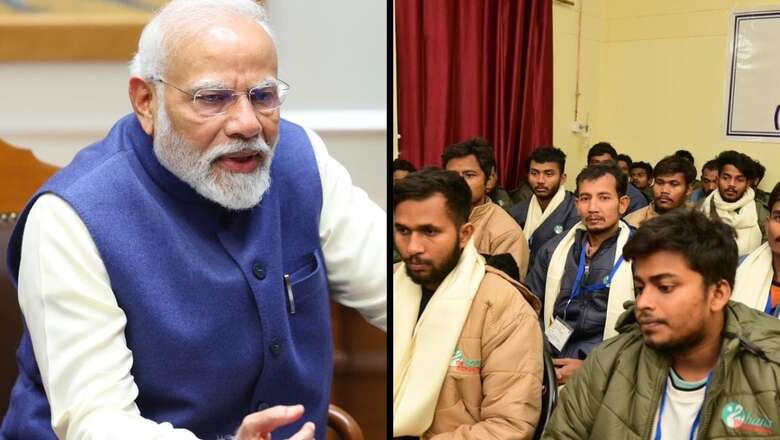
views
In June 2013, a mid-day cloudburst centred on Uttarakhand caused devastating floods and landslides, becoming the country’s worst natural disaster ever. More than 4,500 villages were washed away and, while the official death toll was put at 6,054 people, it is said over 20,000 people were killed in the catastrophe – it could have been averted if the then Manmohan Singh-led Congress government had taken the necessary precautions in time.
Even after the devastation and destruction, people of Uttarakhand were left to fend for themselves with Sonia Gandhi’s kitchen cabinet turning a Nelson’s eye to the annihilation of Uttarakhand and its beautiful people. A man-made disaster was portrayed as a natural disaster and worse still, administrative inefficiency of the erstwhile Congress duo of Sonia-Singh was not even held accountable.
But that is hardly surprising. The Congress has a horrifying history of turning a blind eye to crises of any form or magnitude. More recently, between August and October, due to torrential rains and landslides, 74 people were killed in Himachal Pradesh and 40 people died in Karnataka, both Congress-ruled states. Could the death toll have been averted? Yes. Despite repeated warnings from weather bureaus, the Congress regimes in these two states chose to ignore the weather department and put citizens at peril. It is, therefore, nothing short of rabid hypocrisy when the Congress chooses to question the BJP on its track record in terms of crisis management.
While in 2013, Uttarakhand, under an incompetent Congress was thrown into utter chaos, under the double-engine BJP government in 2023, it has shown to the world how adversity and a potential disaster can be surmounted by super-efficient leadership that thinks and acts.
Prime Minister Narendra Modi deserves unconditional plaudits for not only overseeing a very tricky operation by virtue of being the head of the National Disaster Management Authority (NDMA), but more importantly, bringing this rescue operation to fruition without a single life lost. All 41 workers trapped inside the Silkyara tunnel in Uttarakhand since November 12 were successfully rescued 17 days later. The collapse occurred in the under-construction tunnel due to debris falling in a 60-metre stretch on the Silkyara side.
Excellent coordination between government bodies and Centre
Immediate mobilisation of resources by the BJP government in Uttarakhand and the Modi government at the Centre ensued, to rescue the 41 trapped labourers. Initially opting for a 900 mm pipe through the debris, safety concerns led to the exploration of multiple rescue options simultaneously. The area of entrapment, measuring 8.5 metres in height and 2 km in length, was the built-up portion of the tunnel, offering safety to the labourers with available electricity and water supply. Five agencies – ONGC, Satluj Jal Vidyut Nigam Limited (SJVNL), Rail Vikas Nigam Limited (RVNL), National Highways and Infrastructure Development Corporation Ltd (NHIDCL) and Tehri Hydro Development Corporation Limited (THDCL) – were assigned specific responsibilities, working collaboratively with occasional task adjustments for operational efficiency.
The NHIDCL is a fully owned company of the government while RVNL is an extended arm of the ministry of railways. The THDCL is under the ownership of National Thermal Power Corporation Limited ((NTPC), ministry of power. Similarly, SJVNL is also a public sector undertaking. The limited point is simply this – the Silkyara tunnel rescue operation was a resounding success due to the excellent coordination between various government bodies and the role of the Centre, therefore, has been integral to the success of this exceptional rescue operation, which has received international applause.
Despite minor technical glitches, the challenging Himalayan terrain and unforeseen emergencies over the course of 16 to 17 days, this rescue operation has to be one of the biggest, most difficult, most challenging and yet the most successful of its kind. It requires the ability to take calculated risks, dedication to the cause and unwavering commitment and compassion to do what Prime Minister Modi’s team did.
Extraordinary crisis management under highly extenuating circumstances has been the hallmark of the prime minister’s office (PMO) and the Modi government. Various government agencies worked tirelessly on assigned specific tasks to ensure the safe evacuation of the workers. National and international experts were called in to advise. The PMO maintained constant communication to boost the morale of those trapped. Freshly cooked food and fresh fruits, dry fruits, salts and medicines were being sent inside at regular intervals. Modified communication system with wire connectivity developed by SDRF was used for communication regularly.
Multiple methods adopted to rescue workers
The auger drilling started at midnight on November 22 but was halted due to a metallic object (lattice girder rib) being encountered in front of the pipe, which could not be inserted further. Cutting of metallic objects (lattice girder rib) using gas cutters was completed in the interim. Once obstructions were observed, auger drilling was halted. Thereafter, manual cutting of auger in small pieces by gas cutting and taking it out from inside the pipe (800 mm) was adopted.
Besides vertical drilling at the Silkyara end, horizontal drilling from the Barkot side was also done. The THDCL initiated the construction of a rescue tunnel from the Barkot end, with four blasts complete in the process. Perpendicular-horizontal drilling by RVNL was also undertaken.
Equipment for micro tunneling required for horizontal drilling was brought from Nashik and Delhi to Uttarakhand. Access road of 1,150 metres was completed by BRO in record time and handed over to RVNL. Machine for drilling was towed to location by BRO. Electric connection was provided to RVNL.
Vertical drilling toward Barkot end was done by ONGC. Air drilling rig machine from Indore was brought to site. Drift tunnel by manual semi-mechanised method by joint teams of THDCL/army/Coal India and NHIDCL were pressed into action.
Road cutting and supportive work by BRO was undertaken. The BRO completed construction of approach roads for vertical drilling by SJVNL and RVNL. An approach road was also built for ONGC, with geological surveys conducted. The BRO is a statutory body under the defence ministry.
PM Modi’s relentless commitment to ‘shramiks’
Digressing from the Silkyara tunnel rescue for a bit and speaking of workers, the PM’s relentless commitment to ‘shramiks’ (workers) has been repeatedly showcased. One such instance was Pradhan Mantri Vishwakarma Yojana (PMVY), launched in September 2023, which will equip craftspeople with the technology to augment their skills for the modern market.
The first phase of the Rs 5,400-crore state-of-the-art India International Convention and Expo Centre, named ‘Yashobhoomi’ at Dwarka in New Delhi, was also launched in September to further boost this initiative of harnessing skills of traditional craftsmen and women, so as to generate productive employment.
“Today, I dedicate ‘Yashobhoomi’ to every labourer, every ‘Vishwakarma’ of the nation,” Modi had said. “We are living at a time when there is such a government in the country that provides recognition and help to marginalised people,” he added.
The Vishwakarma scheme aims at enhancing the accessibility and quality of products and services offered by traditional artisans and craftspeople. The scheme offers collateral-free enterprise development loans of Rs 1 lakh (first tranche to be repaid in 18 months) and Rs 2 lakh (second tranche to be repaid in 30 months). A concessional rate of interest of 5 percent will be charged from the beneficiary, with interest subvention cap of 8 percent to be paid by the ministry of micro small and medium enterprises (MSMEs). The credit guarantee fee will be borne by the Modi government.
Speaking of Yashobhoomi, Modi said the conference tourism sector, estimated at Rs 25 lakh crore, presents a massive opportunity for India. With a total project area of over 8.9 lakh sq m and built up area of more than 1.8 lakh sq m, Yashobhoomi will find its place among the world’s largest MICE (meetings, incentives, conferences and exhibitions) facilities, he said. Yashobhoomi has the complete ecosystem for organising conferences and exhibitions and will provide job opportunities to several lakh people.
“Through the Yashobhoomi convention centre alone, lakhs of youth are expected to secure employment opportunities,” the PM had said. Yashobhoomi is also being connected to the Delhi Airport Metro Express line, with the inauguration of a new metro station – ‘Yashobhoomi Dwarka Sector 25’.
Bhopal Gas Tragedy: Warped priorities of Rajiv Gandhi-led government
Moving away from Yashobhoomi, let us go back in time to 1984. In 1984, the horrifying Bhopal gas tragedy left millions dead and homeless as well as thousands disabled, maimed and diseased for life. The prime minister then was none other than Rajiv Gandhi, father of Congress scion Rahul Gandhi. Instead of bringing to book the guilty, Rajiv Gandhi gave safe passage to Union Carbide chairman Warren Anderson and that, too, within barely four days of the tragedy.
This clearly shows how warped Rajiv Gandhi’s priorities were. He, in fact, secured the release of Adil Shahryar from the erstwhile Ronald Reagan dispensation, in lieu of handing over Anderson to the US. Adil is the son of Mohammad Yunus, an Indian civil servant and former ambassador to Turkey, Indonesia, Iraq and Spain. Yunus, let it be known, was a close friend of not only Rajiv Gandhi but also an associate of his grandfather Jawaharlal Nehru and his mother Indira Gandhi. Adil was found guilty on five occasions, including arson, felony and fraud, by a Florida district court and had been sentenced to 35 years in prison. To cut a long story short, to secure the safe release of Adil Shahryar, Rajiv Gandhi ignored the pain, suffering and destruction faced by millions of Indians in the Bhopal gas tragedy and ensured Anderson’s escape. To say he had blood on his hands would not be incorrect.
PM Modi, eternal ‘karmayogi’ and unrelenting ‘paropkaari’
Coming back to crisis management, there is none like Modi. From ‘Operation Raahat’ and ‘Operation Maitri’ in 2015, where thousands of Indians stranded in Yemen and Nepal were safely rescued, to ‘Operation Devishakti’ in 2021 where Indians were rescued from Afghanistan and ‘Operation Ganga’ in 2022, where thousands of Indian students were rescued from Ukraine – Modi’s commitment by always putting India and Indians first, is extraordinary.
In 2023, yet again, be it ‘Operation Kaveri’ to rescue Indians from Sudan or ‘Operation Dost’ to rescue Indians from Syria and Turkey, or for that matter ‘Operation Ajay’ to rescue Indians from Israel, the Modi government’s humanitarian efforts and decision to never give up on any Indian in any part of the world, is an ode to what committed leadership is made of. And needless to add, Modi is that leader, a ‘paropkaari’, whose work speaks for itself.
In the final analysis, disaster management is not everyone’s cup of tea. “Crisis makes us make decisions based on results and not what is right,” said Janna Cachola. But, it was never a tough choice for Modi when the lives of 41 workers were at stake. He was clear from the beginning that nothing else mattered – only that every single life was precious. There was never any “if” or “but” playing on his mind. When faced with an unprecedented crisis, he made decisions both right and also driven by the right results.
Eventually, the Silkyara success story stands as a symbol of human resilience, endurance and faith; but most of all, it is about what outstanding leadership can achieve. That leader in this case is Modi, the eternal ‘karmayogi’ and the unrelenting ‘paropkaari’.
(Sanju Verma is an economist, national spokesperson of the BJP and bestselling author of ‘The Modi Gambit’)

















Comments
0 comment